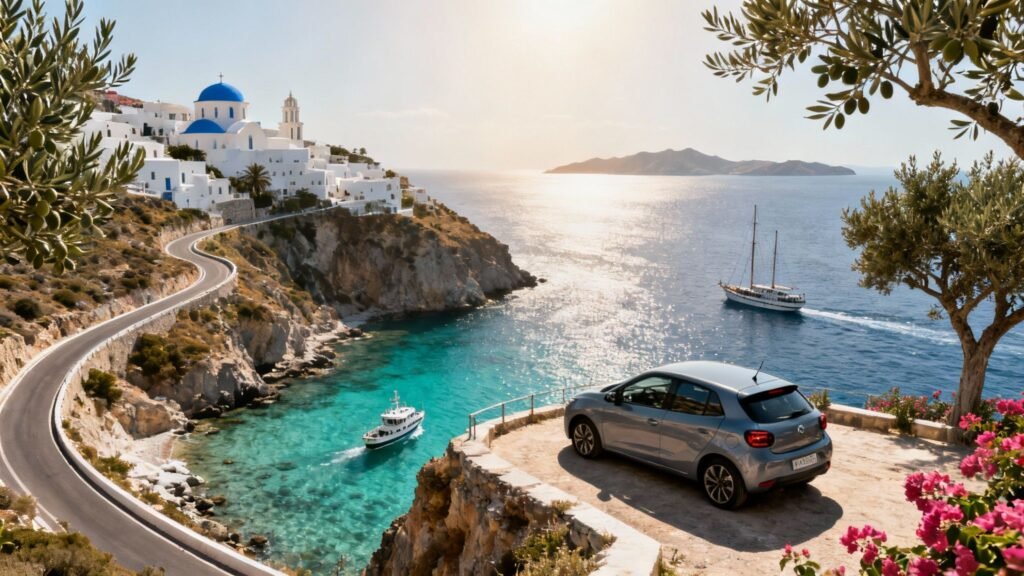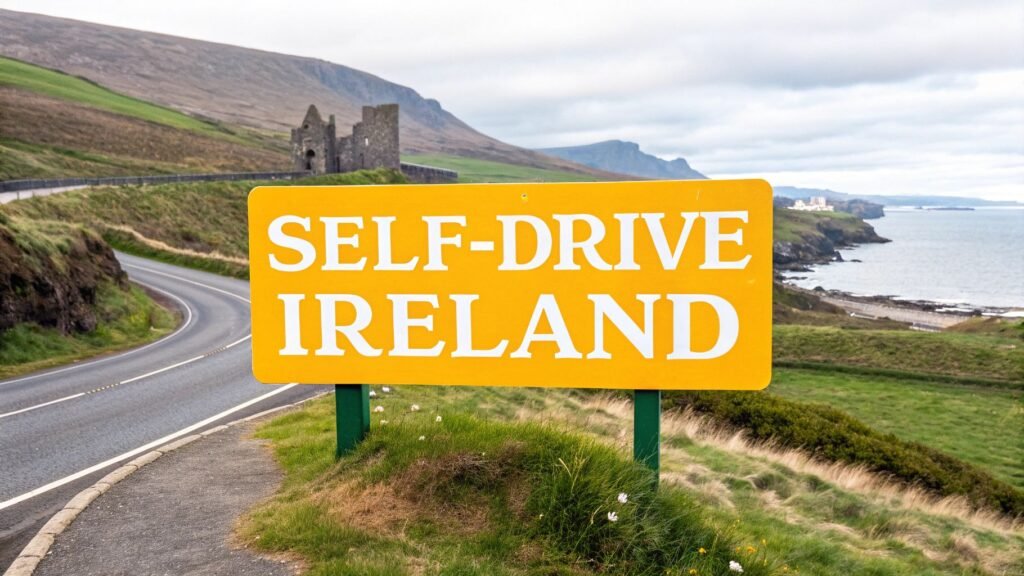A tour of the Greek islands is more than just a holiday; it’s an invitation to a world where ancient myths live alongside sparkling blue waters and sun-drenched villages. Hopping from one island to the next is really the only way to do it properly. It gives you the freedom to chase your own adventure, from the legendary sunsets in the Cyclades to the impossibly green landscapes of the Ionian islands.
Your Ultimate Greek Island Hopping Guide
Consider this your complete handbook for planning an unforgettable trip across the Aegean and Ionian seas. We’re going beyond the postcard pictures to give you the practical, real-world advice needed to craft a journey that truly connects you with the heart of Greece. This is about getting off the beaten track and discovering the incredible diversity that makes a Greek island tour so special.
Island hopping is a state of mind. It’s the excitement of watching the sunrise over one island and settling down for dinner on another, each with its own unique flavour, food, and story. This guide is designed to give you all the tools and confidence you need to make that happen.
What This Guide Covers
We've laid everything out to walk you through the planning process, step by step. From the first flicker of an idea to locking in the final details, we'll make sure you feel completely ready for the adventure ahead. If you're looking for pre-planned itineraries to spark some inspiration, you might find our broader guide on exploring https://btours.com/greece/ a helpful starting point.
For this guide, we're focusing on the three things that make or break any island-hopping trip:
- Itinerary Planning: We'll help you pick the right islands for your kind of holiday. Are you looking for buzzing nightlife, quiet hidden coves, or a deep dive into ancient history? We've got you covered.
- Transport & Logistics: Ferries can seem complicated, but they don't have to be. We’ll break down how the system works, talk through your rental options, and share our best tips for making island-to-island travel a breeze.
- Budget Management: We’ll give you a realistic idea of what things cost – from accommodation and food to activities – so you can plan a trip that’s comfortable for your wallet.
This diagram shows how these key pieces fit together.
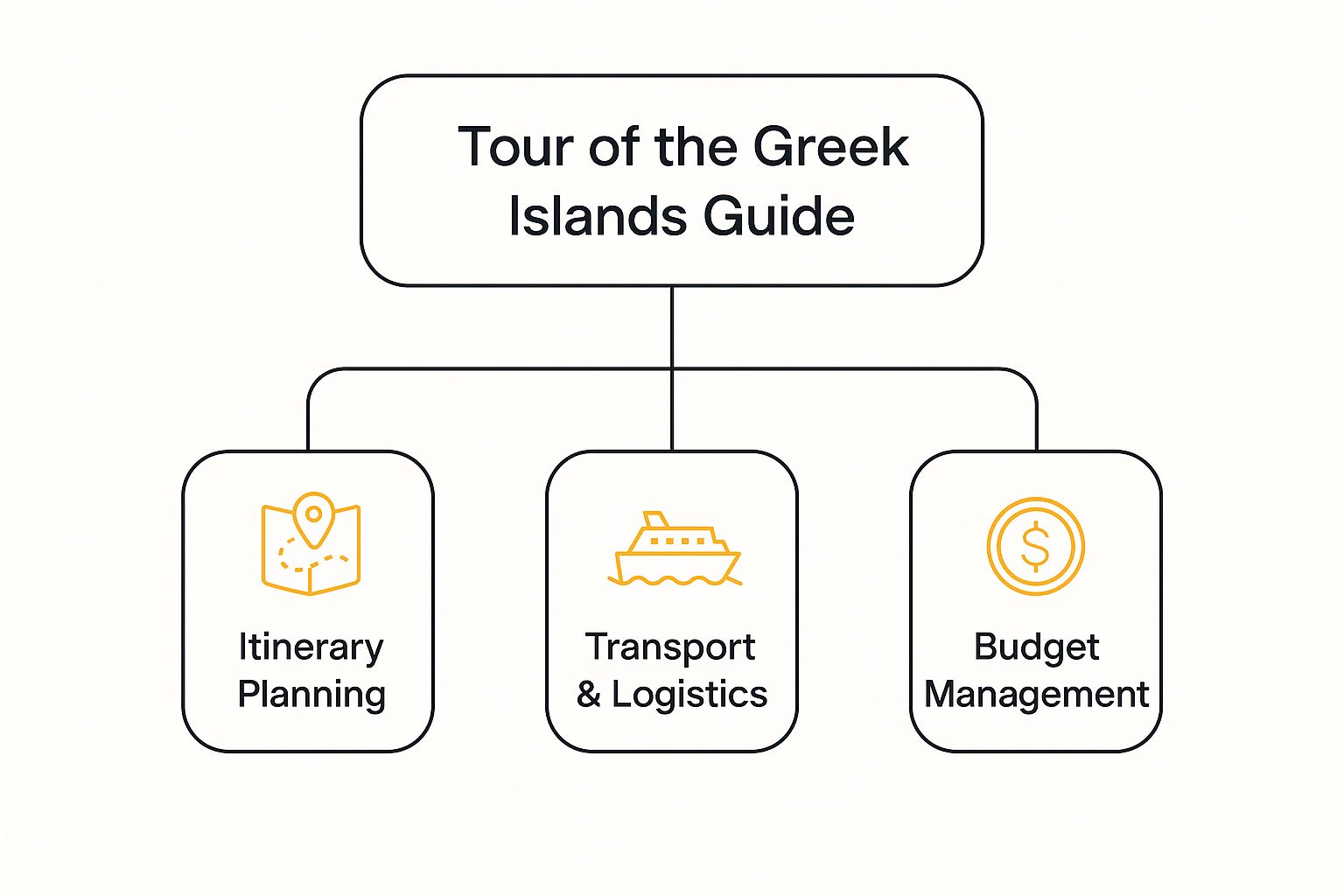
Getting this structure right is the secret to a relaxed and memorable trip. And while you're getting all the practicalities sorted, it's also fun to think about what to pack; checking out some beach vacation outfit ideas will ensure you look and feel the part for every sunset cocktail and seaside stroll.
Right, let's start building your perfect Greek island tour.
How to Choose Your Perfect Greek Island Group
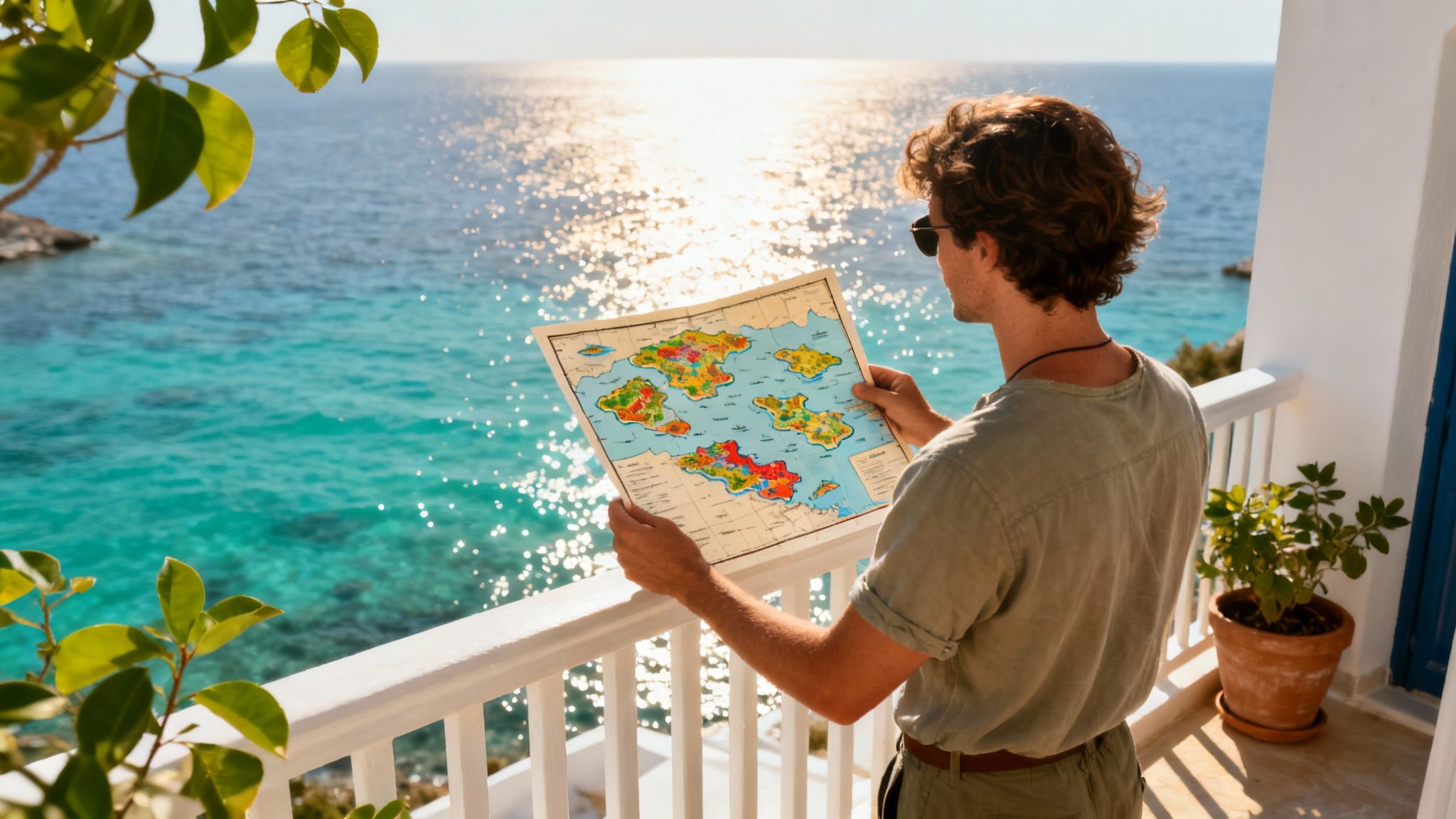
Trying to plan a tour of the Greek islands without knowing which island group to visit is a bit like walking into a massive, beautiful library with no idea what you want to read. You could wander for days and just feel overwhelmed. Greece has over 200 inhabited islands, and they’re clustered into distinct groups, each with its own unique personality, landscape, and rhythm.
Think of these island groups as different playlists for your holiday. The Cyclades are the iconic, upbeat summer hits everyone knows and loves. The Ionian islands are a lush, laid-back acoustic set, perfect for chilling out. Getting to know these unique characters is the first—and most exciting—step in creating your perfect trip. This section will help you match your personal travel style to the ideal cluster of islands, whether you're after adventure, history, family fun, or pure relaxation.
To help you decide, let's take a quick look at the main contenders. Each group has a completely different feel, so finding the right fit is key to an unforgettable trip.
Greek Island Groups at a Glance
| Island Group | Best For | Vibe | Example Islands |
|---|---|---|---|
| The Cyclades | First-timers, couples & iconic views | Energetic, stylish & classic | Santorini, Mykonos, Naxos |
| The Ionian | Nature lovers & beach connoisseurs | Lush, relaxed & Venetian | Corfu, Zakynthos, Lefkada |
| The Dodecanese | History buffs & cultural explorers | Historic, multicultural & medieval | Rhodes, Kos, Patmos |
| The Sporades | Families, hikers & Mamma Mia! fans | Green, natural & unspoilt | Skiathos, Skopelos, Alonissos |
Hopefully, that gives you a starting point. Now, let's dive a little deeper into what makes each of these incredible regions tick.
The Cyclades: Iconic Beauty and Bustling Energy
When you close your eyes and picture Greece, chances are you’re imagining the Cyclades. This is the absolute epicentre of the classic Greek island experience, famous for its sugar-cube villages tumbling down cliffsides, blue-domed churches against a brilliant white backdrop, and golden beaches meeting turquoise water.
The vibe here is undeniably energetic and stylish, especially on islands like Mykonos and Santorini. They are the undisputed stars of the show, offering world-class nightlife, chic hotels, and sunsets that you have to see to believe. But there’s so much more to the Cyclades than just the headliners. Naxos boasts some of the longest, sandiest beaches in the Aegean and has a wonderful, family-friendly atmosphere. Paros, on the other hand, strikes that perfect balance between lively harbour towns and quiet, hidden coves.
- Best For: First-time visitors, couples, groups of friends, and anyone chasing those iconic views and a vibrant social scene.
- Don't Miss: The sunset in Oia (Santorini), getting lost in the charming port of Naoussa (Paros), and kicking back on the endless sands of Agios Georgios beach (Naxos).
This group is also incredibly well-connected by ferries, making it the easiest choice by far for a seamless island-hopping adventure. If you'd rather have someone else handle the logistics, our pre-planned Cyclades island hopping tour is a fantastic way to experience the highlights.
The Ionian Islands: Lush Landscapes and Venetian Charm
Head over to the west coast of mainland Greece and you’ll find the Ionian islands—a completely different, greener version of Greece. Forget the arid, rocky landscapes of the Aegean; the Ionians are covered in dense forests of olive groves and cypress trees that roll right down to the electric-blue sea.
Their long history under Venetian, French, and British rule has also left a distinct mark on the culture and architecture. You'll find elegant, Italian-style towns in Corfu, staggering cliff-backed beaches in Zakynthos (home to the world-famous Shipwreck Beach), and the legendary home of Odysseus in Ithaca. The pace of life here is noticeably slower and more relaxed than in the Cyclades.
The Ionian islands are where nature truly takes centre stage. The dramatic contrast between the emerald-green hills and the impossibly blue sea creates some of the most stunning coastal scenery in all of Europe.
It seems travellers are catching on, too. Recent data shows a huge surge in interest from British travellers looking beyond the usual hotspots. In fact, bookings for the Ionian island of Lefkada for 2025 have jumped by an incredible 1,167%. This points to a growing desire for more authentic and adventurous trips, a trend you can read more about in this analysis of emerging travel trends from Ferryscanner.
The Dodecanese: Rich History and Medieval Wonders
Tucked away in the southeastern Aegean, close to the coast of Turkey, the Dodecanese islands are a rich tapestry of interwoven cultures and histories. Their strategic location made them a crossroads for civilisations for millennia, and they are practically an open-air museum because of it.
Rhodes is the undisputed powerhouse of the group, home to a magnificent UNESCO-listed medieval Old Town built by the Knights of Saint John. Nearby, Kos offers a fantastic mix of ancient Greek and Roman ruins alongside its bustling beaches and lively town centre. For a quieter, more traditional experience, you can escape to islands like Patmos, where the Book of Revelation was written, or Symi, with its picture-perfect neoclassical harbour.
A tour through the Dodecanese really feels like a journey back in time, making it the perfect choice for history buffs and anyone with a curious spirit.
The Sporades: Verdant Nature and Unspoilt Beaches
Often called the "Emerald Isles," the Sporades are a small, lush cluster of islands just off the eastern coast of the Greek mainland. The main islands—Skiathos, Skopelos, Alonissos, and Skyros—are blanketed in thick pine forests, creating a wonderfully natural and refreshing atmosphere.
Skiathos is the most popular, known for its vibrant town and over 60 beautiful sandy beaches. Skopelos shot to international fame as the filming location for "Mamma Mia!" and continues to captivate visitors with its traditional villages and unspoilt coastline. Alonissos is the quietest of the trio; it’s home to a national marine park that protects the endangered Mediterranean monk seal, making it a paradise for nature lovers, hikers, and scuba divers.
This is the ideal island group for anyone who wants to pair beautiful beach days with adventures in a pristine, natural environment.
Mastering Your Island Hopping Logistics
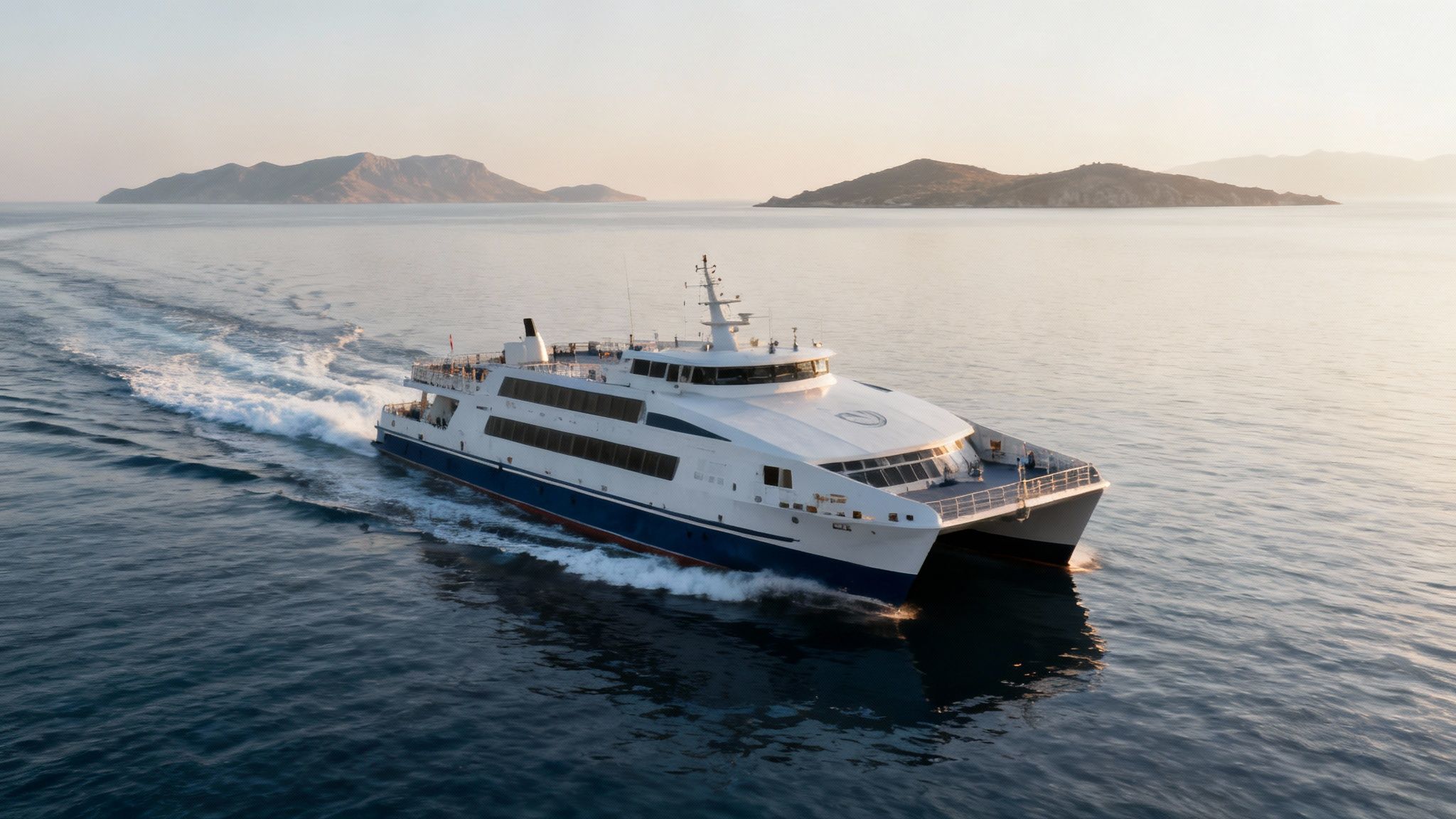
So, you've sketched out your dream route. The next part is where the magic really happens—turning those lines on the map into a real, seamless adventure. This is all about logistics, and honestly, navigating the ferries and connections is a huge part of the Greek island experience itself.
Don't think of the Greek ferry system as a hurdle. It's the beautiful, intricate web that holds your whole journey together. Getting the hang of it is the secret to a genuinely stress-free trip. It’s about knowing your options, booking with confidence, and turning what could be a tricky part of your travels into just another great memory.
Decoding the Greek Ferry System
The ferry network is the lifeblood of the islands. It’s how everything moves—goods, locals, and travellers like you. When you’re booking, your main decision will be between two kinds of boats, and they each offer a completely different vibe.
1. Conventional Ferries: These are the big, traditional workhorses of the Aegean and Ionian seas. They're slower, much more stable in the water, and a lot easier on the wallet. A trip on one of these is an experience in itself. You can wander the decks, feel the sea breeze, and watch the islands slowly appear on the horizon. If you’re not in a hurry and want to soak it all in, this is your best bet.
2. High-Speed Ferries (Catamarans): Think of these as the slick, modern speedboats of the island-hopping world. These catamarans and hydrofoils can slash your travel time in half, a game-changer if you’re on a tight schedule. The trade-off? They're pricier, seating is usually assigned inside (think aeroplane style), and they're the first to be cancelled when the winds pick up.
Choosing your ferry is really about choosing your pace. The slow, conventional ferry is a scenic cruise, a proper part of the day's journey. The high-speed catamaran is a quick transfer, getting you from A to B so you have more time to explore on land.
While you're sorting out the practical side of your trip, it’s always smart to have a plan for the unexpected. Knowing some good tips for handling lost luggage can save you a massive headache and give you some peace of mind if a bag goes astray.
When Flights Are a Smarter Bet
Ferries are the soul of island hopping, but sometimes, a short flight just makes more sense. This is especially true if you're trying to jump between distant island groups—say, from the Ionian islands over to the Cyclades. A journey that could take a full day by boat becomes a quick one-hour flight.
This strategy is getting more and more popular. The summer of 2025 saw a record number of flights between the UK and Greece, especially to the islands. July 2025 alone hit a new high with about 5.3 million international flight seats, up 3.8% from the year before. This tells us that savvy travellers are using flights to maximise their precious holiday time on the ground.
Practical Tips for Smooth Sailing
Booking your travel is pretty straightforward these days, but a few local tips can make all the difference. Follow these pointers, and your island-to-island journeys will be as relaxing as a day on the beach.
- Book Well in Advance: If you’re travelling in peak season (July-August) or on a popular route, you need to book your ferries and flights weeks, or even months, ahead. It guarantees you a spot and often saves you a bit of cash.
- Handle Your Luggage Like a Pro: On ferries, you’ll usually leave big suitcases on the car deck in designated racks. Keep a small day bag with you holding your valuables, tickets, and anything you might need for the trip.
- Get to the Port Early: Greek ports can be a bit chaotic, especially in summer. Plan to arrive at least 45-60 minutes before your ferry is due to leave. This gives you plenty of time to find your way, grab tickets if needed, and board without that last-minute panic.
A little planning really does go a long way. For anyone dreaming of the lush, green Ionian islands, our guide to an Ionian island hopping adventure is a perfect example of a well-planned itinerary.
Budgeting for Your Greek Island Tour
Getting your budget right is the first, and most crucial, step in turning that dream tour of the Greek islands from an idea into reality. Think of it as the foundation for your whole adventure; it's what dictates where you'll go, how long you'll stay, and what you'll do when you get there. The brilliant thing about Greece, though, is its incredible versatility.
There’s a version of this trip for absolutely everyone, whether you’re a backpacker on a shoestring, a couple seeking a bit of boutique luxury, or a family ready to splash out. Knowing what you want to spend from the outset simply allows you to piece together the experiences that matter most to you, making for a trip that’s both unforgettable and free from financial stress.
At its core, your budget will boil down to three things: where you sleep, what you eat, and how you spend your days. Get a handle on these, and you'll be able to make your money work for you, not the other way around. Let's dig into what you can realistically expect to spend.
Decoding Accommodation Costs
Where you lay your head each night will likely be the biggest slice of your budget. The Greek islands are packed with options, each offering a completely different vibe and price point.
- Budget-Friendly Stays (£30-£70 per night): Keep an eye out for domatia (simple, family-run rooms for rent) or small guesthouses. They're often basic but always clean, comfortable, and give you a real taste of local life. You’ll also find hostels on party-centric islands like Ios and Mykonos.
- Mid-Range Comfort (£70-£150 per night): This is the sweet spot for most travellers. In this range, you'll find everything from chic boutique hotels and stylish self-catering flats to charming hotels with their own pools. You get great amenities and locations without breaking the bank.
- Luxury Retreats (£150+ per night): If you're looking to indulge, you're in luck. The islands are brimming with incredible villas, five-star resorts, and exclusive hotels boasting private plunge pools and those iconic caldera views. Expect top-tier service in breathtaking settings.
A crucial tip: book your accommodation well ahead of time, especially if you’re travelling in the peak months of July and August. It not only guarantees you get the place you want but often locks in a much better price before they climb with last-minute demand.
Your Daily Spending Guide
Once your room is sorted, your day-to-day spending on food and fun is where you have the most flexibility. One of the best ways to save money—and have a better experience—is to eat at local tavernas. They’re far more authentic and much easier on the wallet than the tourist traps on the main drags.
Here’s a rough idea of what to budget per day:
- Backpacker: £40-£60 per day. This covers budget rooms, a diet of gyros and souvlaki, getting around on public transport, and sticking to free activities like hiking and beach hopping.
- Mid-Range: £90-£140 per day. This opens the door to comfy hotels, a mix of simple taverna meals and the occasional fancier dinner, renting a scooter or small car, and paying for things like boat trips or museum tickets.
- Luxury: £200+ per day. This budget allows for high-end dining, private tours, car hire, and access to exclusive beach clubs, ensuring a trip filled with pure comfort and indulgence.
It’s worth remembering that this spending is the lifeblood of the local economy. Throughout 2025, tourism has been a major driver of Greece's economic health, with travel receipts climbing 11% in the first half of the year over 2024. In June 2025 alone, income from EU-27 residents hit an astonishing €1.74 billion, showing just how much of a positive impact your holiday has. You can read more about these tourism spending trends from Euronews.
Top Tips for a Cost-Effective Tour
Sticking to a budget isn’t about missing out; it’s about travelling smarter. A few clever decisions can make your money go a whole lot further.
- Travel in the Shoulder Season: May, June, September, and early October are the magic months. You get glorious weather, far fewer people, and much lower prices on flights and accommodation.
- Embrace the Taverna: Don't just eat at the first place you see. Wander a street or two back from the main harbour or square to find the family-run spots. The food is almost always better and the prices are far more reasonable.
- Book Ferries in Advance: For longer ferry journeys between island groups, book your tickets online using a comparison site. You'll often find much better fares than buying on the day.
- Plan Your Transport: While a car offers total freedom, the public bus systems (known as KTEL) on many islands are surprisingly good and cheap. We find a mix works best, which is why our flexible self-drive tours are designed to balance cost with convenience.
Experiencing Authentic Greek Culture
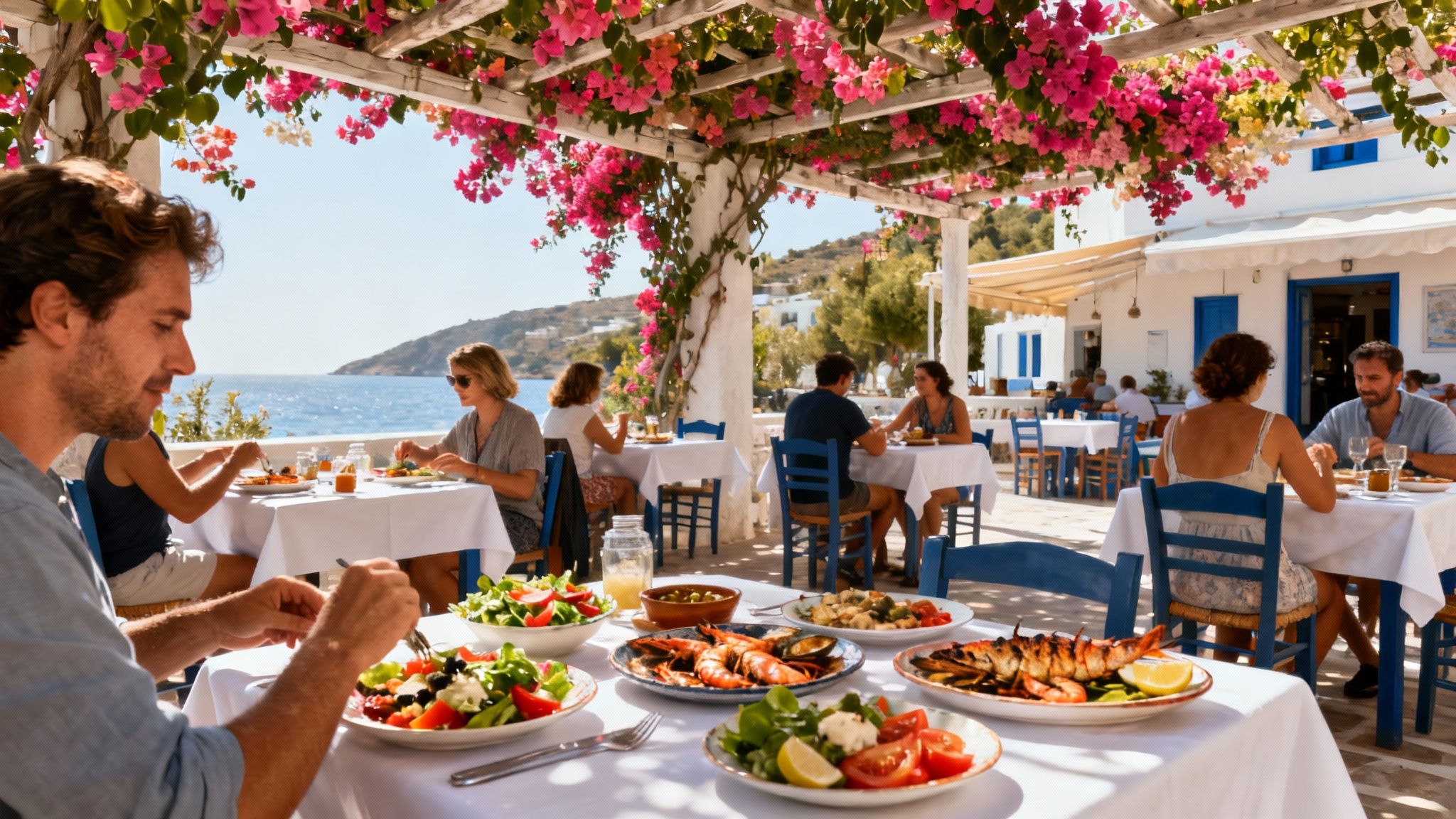
A tour of the Greek islands is so much more than ticking off beautiful beaches and ancient ruins. It's a chance to immerse yourself in one of the world's most vibrant, living cultures. To really get under the skin of the islands, you have to look beyond the well-trodden tourist paths and connect with the local way of life.
It's all about slowing down to the island's gentle rhythm, engaging with the community, and simply embracing a different pace. This mindset shift is what turns a standard holiday into a genuinely rich and memorable experience, transforming you from a mere visitor into a welcomed guest.
Embracing the Spirit of Filoxenia
At the very core of Greek culture is the concept of 'filoxenia'. The literal translation is "love of strangers," but its meaning runs much deeper. It’s an ancient code of conduct, a genuine warmth and generosity towards visitors that is stitched into the fabric of the Greek identity.
You’ll feel it everywhere. It's in the taverna owner who brings you a complimentary slice of watermelon or a small glass of ouzo after your meal. It’s in the friendly wave from a local tending their garden as you drive past, or the shopkeeper who pauses to share a little story about their village.
Filoxenia isn't just about being friendly; it's a profound cultural obligation to make guests feel at home. To truly appreciate your tour of the Greek islands, embrace this spirit. Be open, be respectful, and be genuinely curious about the people you meet. A simple smile and a "kalimera" (good morning) can open doors to some wonderful interactions.
Responding to this warmth with grace and a genuine 'thank you' is key. It's a two-way street that makes your travels far more meaningful and leaves a positive impression, fostering a connection that money can't buy.
Savouring the True Flavours of the Islands
Greek food is a pure celebration of fresh, local ingredients, and believe me, every island has its own distinct culinary personality. Of course, souvlaki and moussaka are fantastic, but the real adventure begins when you start exploring the regional specialities. My advice? Ditch the tourist-trap menus and hunt down the family-run tavernas tucked away in village squares.
Look for dishes that showcase what that specific island is famous for. For instance, on Naxos, an island renowned for its agriculture, you absolutely must try the rich, sharp arseniko cheese. Over in Santorini, the unique volcanic soil yields the most incredible cherry tomatoes and white aubergines you’ll ever taste, and they feature heavily in local recipes.
Here are a few things to keep an eye out for on menus to get a more authentic taste:
- Gemista: A cornerstone of home-style Greek cooking. These are big, juicy tomatoes and peppers stuffed with herbed rice and baked until tender.
- Fava: A creamy split pea purée, often drizzled with local olive oil and topped with capers. Santorini's version is particularly famous.
- Saganaki: This isn't just fried cheese! It’s a style of cooking in a small, two-handled pan. Look out for shrimp saganaki—prawns simmered in a rich tomato and feta sauce.
- Melitzanes Papoutsakia: The name means "little shoes," and that’s what they look like! Aubergines are hollowed out, filled with a savoury meat or vegetable mixture, and topped with a creamy béchamel sauce.
Eating this way connects you directly to the land and the local community. It’s a delicious lesson in an island's history, agriculture, and culture, all served on one plate.
Navigating Cultural Etiquette
A little bit of cultural awareness goes a long way in making sure your interactions are respectful and positive. Greeks are generally very relaxed and easy-going, but showing you appreciate a few local customs will be warmly received.
Dress with Respect
When visiting monasteries and churches, modest dress is essential. This means covering your shoulders and knees. Many places offer wraps or skirts at the entrance for visitors, but it's always a good idea to come prepared with your own scarf or pop a pair of long trousers in your bag.
Learn a Few Phrases
Nobody expects you to be fluent, but learning just a few basic Greek words shows you’re making an effort, and it’s hugely appreciated.
- Kalimera (ka-lee-ME-ra) – Good morning
- Kalispera (ka-lee-SPE-ra) – Good evening
- Efcharisto (ef-ka-ree-STO) – Thank you
- Parakalo (pa-ra-ka-LO) – Please / You're welcome
Embrace Island Time
Things simply move at a more leisurely pace on the islands—it’s part of the charm! Don't be surprised if shops close for a siesta for a few hours in the afternoon. Instead of getting frustrated, lean into it. Adopt the local rhythm, enjoy a long, lazy lunch, and relax. This is the very essence of island life.
Got Questions About Touring the Greek Islands?
Planning your first trip to the Greek islands is exciting, but it's bound to bring up a few questions. It’s totally normal to wonder about the best time to go, how many islands you can realistically visit, and whether you really need to book everything before you leave.
This section tackles all those common queries head-on. Think of it as a final chat with an expert to make sure you're feeling confident and ready for the adventure. Once these practicalities are sorted, you can get back to dreaming about the important stuff: finding the perfect hidden cove, soaking up the sun, and discovering your new favourite taverna.
What’s the Best Time of Year to Tour the Greek Islands?
Hands down, the best time for a Greek island tour is during the shoulder seasons. That means late spring (May to June) or early autumn (September to October). During these months, the weather is gorgeous, the sea is warm enough for a proper swim, and the crowds are noticeably thinner than in the height of summer.
You'll also find that flights and accommodation are a bit easier on the wallet, making your budget stretch that much further. Of course, July and August bring the hottest weather and a buzzing nightlife scene, but they also come with peak-season prices and crowds to match. For a more relaxed trip that gives you the best of both worlds, the shoulder seasons are the clear winner.
By travelling in May, June, or September, you strike the perfect balance. You get that classic sunny Greek island experience without the intense heat and crowds of high summer, which makes for a much more comfortable and authentic journey.
How Many Islands Should I Visit on a Two-Week Tour?
For a two-week holiday, aiming for three or four islands is a brilliant rule of thumb. This pace gives you at least three full days on each island, which is just enough time to explore beyond the main port, find those out-of-the-way beaches, and really get a feel for the unique character of each place without feeling like you're constantly on the move.
Trying to cram in too many islands is a classic rookie mistake that quickly leads to travel fatigue. You can end up feeling like you're spending more time on ferries than actually enjoying yourself. Remember, the whole point of a tour of the Greek islands is to unwind and explore, not just tick names off a list.
Prioritising quality over quantity is the real secret to a memorable island-hopping trip. It gives you the space to be spontaneous – whether that’s lingering over a long, lazy lunch or spending an extra afternoon at a beach you’ve completely fallen for.
Do I Need to Book Ferries and Accommodation in Advance?
Yes, for the most part, you absolutely should book your ferries and accommodation well ahead of time. This becomes critical if you’re travelling during the peak season of July and August, or if you have a tight itinerary you need to stick to.
Popular high-speed ferry routes can, and often do, sell out. Leaving it to the last minute could throw a real spanner in the works. Nailing down your accommodation early not only secures your spot in a great hotel or villa but often locks in a much better price, too. It’s all about peace of mind.
Now, if you’re travelling in the shoulder season and fancy a bit more flexibility, you might get away with booking ferries a few days ahead and finding a room on arrival. But that always comes with a bit of a risk. For a truly stress-free holiday, booking your main transport and at least your first night's stay on each island is always the smartest move.
Is It Necessary to Rent a Car on the Greek Islands?
Whether you need a car really comes down to the size of the island and what you want to get out of your visit. Your transport needs can change dramatically from one stop to the next.
On smaller, more compact islands like Hydra or Folegandros, cars are often unnecessary (or even banned!), and you can get around perfectly well on foot, by bus, or with a local water taxi. That’s a big part of their charm.
On the other hand, for larger islands like Crete, Rhodes, Corfu, or Naxos, renting a car is almost essential if you want the freedom to discover remote beaches, traditional mountain villages, and ancient ruins on your own schedule. A car gives you the keys to craft your own adventure, far from the main tourist trails.
For a happy medium, think about these options:
- Public Transport: Most islands have a surprisingly good and affordable public bus system, known locally as the KTEL. It's a great way to get between the main towns and popular beaches.
- Scooters or ATVs: On islands like Paros or Milos, renting a scooter or an All-Terrain Vehicle (ATV) is a fantastic, fun alternative. They’re a breeze to park and give you that incredible feeling of open-air freedom as you zip along the coastline.
Ultimately, the best strategy is often a flexible one. You might find yourself mixing and matching your transport to suit each island's unique layout and your plans for the day.
At BTOURS, we specialise in creating perfectly planned self-drive adventures that give you the freedom to explore at your own pace. Discover our curated Greek island itineraries and start planning your unforgettable journey today.

